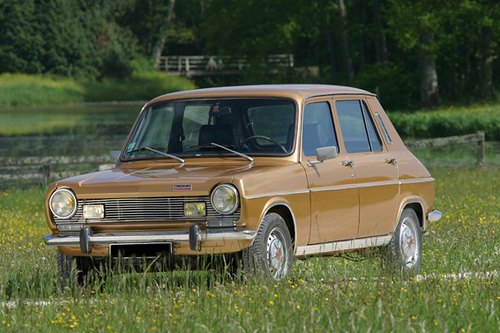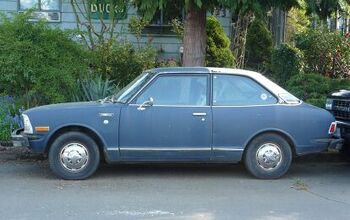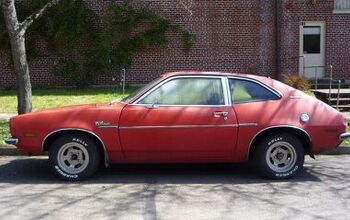Curbside Classics: 1971 Small Cars Comparison: Number 2 - Simca 1204

Curbside Classics is taking you back to 1971 for a virtual comparison test of six small cars, based (and partly borrowed) from a C/D test.
I don’t have any shots of the Simca 1204. I haven’t seen one in over twenty-five years; have you? So I’m taking my lifeline (to Google images). The Simca 1100/1204 was such a remarkable and historically significant car, perhaps the most influential small car since WWII. Its DNA is in every transverse-engine FWD hatchback in the world. The VW Golf was a perfect crib of the Simca wearing a handsome Italian suit. Plus, j’aime les voitures françaises. And the Simca almost won the C/D test. It should have won. So forgive me, but we’re going to have show and tell without the show.
Given how boring, cheap, predictable and ugly most small French cars have become in recent times, it’s hard to fully appreciate how innovative, influential and fun they once were. I’m going to avoid a full-on Francophile paean to their automotive glories, because it would become a book. And the well-known heroes like the Citroën Traction-Avant, DS and 2CV are common knowledge. But the French way of building cars extended to the lesser makes as well, even Chrysler’s subsidiary Simca.
It started from the bottom up with the suspension. OK, we all know the horrors of the complicated and leaking Citroën hydropneumatic bladders. But the plebian Simca had a long-travel torsion-bar suspension that worked superbly and didn’t leak. Yes, like all French cars back then, the Simca looked like it was going to fall over in the curves. But that didn’t really slow it down much, especially since it was the only car in this comparison riding on sticky radials. Combined with the superb deeply-sprung seats, the Simca, like most French cars of the era, created a feeling of well-being that was head and shoulders above the typical hard-riding penalty-box small cars of the time. This still applies today: what I would give for some of that suppleness in my harsh xBox.
But the real historical significance of the Simca 1100/1204 was its configuration. It was THE forerunner of all modern small FWD hatchbacks: transverse side-by-side engine and transmission, a relatively boxy and roomy but compact body, and a cavernous hatch to transform the rear into a virtual wagon. All the characteristics of every Golf-class and other small cars (built around the globe by the hundreds of millions) started right here.
Yes, other cars previously had parts of this recipe for success. The Autobianchi Primula of 1964 gets a supporting role award, but its engine-transmission layout followed the dead-end BMC formula, and its rear seat didn’t fold down (or did it?). Anyway, none combined all the elements like the Simca. And none were as directly copied like it. And despite the 1204 being a flop in the US, the Simca 1100 was a big success in Europe. Launched in 1967, sales grew strongly, and it became the best selling French car, with 300k units built in 1973.
Simca was already on its last legs in the US when it tossed the 1204 our way as its swan song. A dearth of dealers, suspect reputation, and indifference to innovation made the French proto-Golf a rare bird from day one. But in 1977, I met a fellow automotive Franco-phile in L.A. who had one and let me take it for a spin. The feeling of slipping into something very different was palpable. Comfortable, tall, narrow, weird instrument panel. Ergonomics were not as high on the list of priorities of French cars as comfort and all-round practicality.
A slightly enlarged version of the rear-engined Simca 1000 OHV four powered the 1100/1204. It was a willing if somewhat buzzy mill. And it developed a reputation for certain weaknesses in its upper regions. Nevertheless, despite being the smallest mill in this test, it was the third fastest with a 14.6 in the 0-60. But it just didn’t quite cut the mustard on American freeways. And that French reputation of questionable longevity hung over it like the smell of a freshly-cut Camembert cheese.
The 1204 was just a bit ahead of its time in the US. It needed a modern 1.5 and a 5-speed for serious freeway work. My cousin in Austria had an 1100, and we took some great trips together in it. It was right at home in the narrow streets and twisty Alpine roads of Tirol. My love for French cars would soon flower into a fleet of rugged and reliable Peugeot 404s, but I credit the Simca for that first French kiss.
C/D fell in love too: “we were not prepared for the high level of quality throughout. Its basic structure was so extremely solid that the car was totally without rattles or squeaks…it is a highly sophisticated machine that offers maximum comfort and utility in its class…it is a mystery that Chrysler Corporation keeps it a secret.” Good point. Chrysler should have sold them at Plymouth dealers to get the jump on the copycat Golf/Rabbit.
Instead, they imported the miserable Cricket from England. After that disaster, and the Golf/Rabbit’s success, Chrysler copied the Golf’s looks for the Horizon/Omni, which otherwise was heavily based on the 1100/1204. And the ubiquitous K-cars in turn were the fruit of Chrysler’s experience with the Americanized Horizon.
So who needs photos of the Simca? Every time you see a Reliant, LeBaron, Dodge 600, Caravan, Maserati TC or a host of other K-car derivatives, you’re looking at the Simca’s direct genetic offspring. But that’s another CC story (or two). And I already have the photos.

More by Paul Niedermeyer
Latest Car Reviews
Read moreLatest Product Reviews
Read moreRecent Comments
- Lou_BC Well, I'd be impressed if this was in a ZR2. LOL
- Lou_BC This is my shocked face 😲 Hope formatting doesn't fook this up LOL
- Lou_BC Junior? Would that be a Beta Romeo?
- Lou_BC Gotta fix that formatting problem. What a pile of bullsh!t. Are longer posts costing TTAC money? FOOK
- Lou_BC 1.Honda: 6,334,825 vehicles potentially affected2.Ford: 6,152,6143.Kia America: 3,110,4474.Chrysler: 2,732,3985.General Motors: 2,021,0336.Nissan North America: 1,804,4437.Mercedes-Benz USA: 478,1738.Volkswagen Group of America: 453,7639.BMW of North America: 340,24910.Daimler Trucks North America: 261,959






































Comments
Join the conversation
Well gang, i could post some Simca pictures, but i do not think you would want to see them. I grew up in deep south Georgia where my Dad was a Chrysler service manager in the 60s. We had several Simca cars. I learned to drive in a 69 1204 and had to haul it to the scrap yard in November. Boo Hoo!!! This was the car I learned to drive in, a 4 speed 4 door Maroon 1204. I was hit by a guy in a Mitsubishi Sapporo in 1980. Now you do the math... The car sat for 30 years. Well, it was not alone. I think we had over 24 Simca cars. I sold the last four 1000/1100 (rear engine rear wheel drive) cars this past year, and am having to scrap the remaining 1204 cars as all have rusted way beyond repair. I sure did love those cars. Check out the video a kind fellow posted on YouTube. He titled it "Simca Cemetery" appropriately enough. http://www.youtube.com/watch?v=68Lu4F2hS0A Blessings, Shakota http://www.barefoot-soul.com
Excellent reading! The 1204 was, indeed, a remarkable car! Simca was a trailblazer in this area! The Simca Cemetary was a really sad place. Simca Dave and i travelled down to the south of Georgia to visit the place and shot these photos. By 2009, however, there wasn't much metal holding any of these cars together. Thanks for the great work!! Matt Cotton Lake Parsippany, NJ